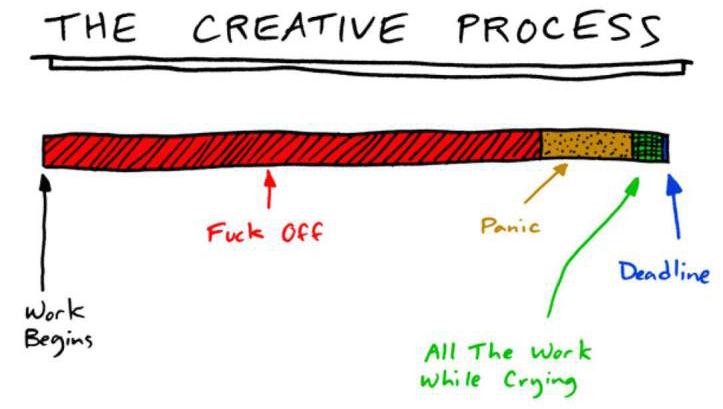Steve Ramos is passionate about design and architecture. He is the founder of the BUILDINGS ARE COOL blog and is an Architect for LS3P in Charleston, S.C.
I enjoy deadlines. It sounds strange to say, but it’s true. Why do I love deadlines?
I think I enjoy the pressure and the intense output that a deadline generates. You will get more done in the four hours leading up to a deadline than the previous eight-hour day (see Parkinson’s Law, explained below).
Deadlines also remind me of architecture school. I definitely don’t hit it as hard, but I still get a touch of nostalgia from working a late night.
The best part is when you are done. Deadlines give you the thrill of finishing something. You have printed the drawings and sent them out the door, and now you can kick back and relax … until the next one!

Although the stress will always be there, you will continue to grow and become more comfortable managing those pesky deadlines. Both architecture school and the professional side of architecture have taught me to be aware of the three constants of architectural deadlines:
1. Murphy’s Law: Anything that can go wrong will go wrong.
My advice is to be most aware of Murphy’s Law on the day of the deadline. Just when you think everything is finished and you are ready to hit the print button, one of these things is likely to happen:
- Software problems: Revit will crash.
- Hardware problems: Your computer will crash.
- The network will go down.
- The printer will run out of paper and/or ink or toner.
- The entire 200-page drawing set will print to the incorrect scale.
- There will be a fire alarm.
- The power will go out.
- One of your team members will have a sick kid on the morning of the deadline.
- Your structural engineer will think the deadline was next week.
- Your client will call the morning of the deadline and say her office needs to be bigger.
- The contractor will call you and say that you can save $220K by eliminating that steel trellis.
Anything that can go wrong will go wrong.

Via Michael Riscica on Pinterest
2. Parkinson’s Law: Work expands to fill the time available for its completion.
Parkinson’s Law rears its head while you are getting ready for Sunday morning church, and it is always floating around the architecture office. Architects tend to work up to the very last second when completing a deadline. If the deadline is extended by a day, then the architect will continue to work.
We just cannot put our (virtual) pencils down!
Perhaps it is because we are perfectionists or because …
3. In architecture, you are never finished.
It can be hard to establish what “complete” means in architecture. Much of what we do is subjective.
The design can always be tweaked. “Maybe we should shift those windows 8 inches to the right?”
A drawing can always be improved. “This elevation would look better if the outline of the building were a thicker line weight.”
Another detail could be added. “We should add a section cut through the fascia of that canopy to show the concealed gutter.”
Even after the building is constructed, an architect will look at it and say, “We should have picked a different mortar color for that brick.” And then one year after a building has been open the architect will get a call from the owner asking for the serial number of the heated towel racks.
In architecture, you are never finished.

Via Mind the Post
One More!
This last one comes as a result of the previous three constants. Maybe this is the conclusion?
However long you think a task or project will take … double it! Or triple it!
Whether it is Murphy’s Law, Parkinson’s Law or our inability to put our pencils down, tasks always seem to take longer than you think. If you think it will take six hours to complete your stack of redlines, try 12. If you think that it will take 40 hours to complete a capacity study for that site, it will probably take 80 or 120.
You can call us perfectionists, or perhaps we are just bad at estimating.
Either way, have no fear. These deadline rules have been around forever and your team will be prepared. Head this way for five tips that will help you to manage those pesky deadlines.
This post first appeared on Buildings Are Cool.Enjoy this article? Check out more of our Young Architect Guides:
The 7 Secrets to Happy Interning
7 Tips for Getting Hired After Graduation
Building Great Architecture Models
5 Lies Told About the Profession You Must Ignore
How to Convince Your Audience With a Powerful Project Narrative
How to Write About Architecture
5 Specifying Tips for First-Time Architects
Browse the Architizer Jobs Board and apply for architecture and design positions at some of the world’s best firms. Click here to sign up for our Jobs Newsletter.
Top image via Architect in Person









